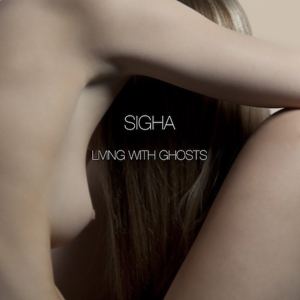Sigha Living with Ghosts
Over the course of two years and 11 releases, James Shaw (a.k.a Sigha) has made […]

Over the course of two years and 11 releases, James Shaw (a.k.a Sigha) has made a gradual shift away from the fractured, ambient garage of his earliest tunes, moving instead toward a wholehearted embrace of the spartan power of European techno. It’s a sonic change that logically matches Shaw’s geographic relocation, as he started his production career in London, but now resides in Berlin. As such, it comes as little surprise that his debut full-length does away with almost all traces of the kick-n’-stick 2-step of early tracks like “Rawww” and “On The Strip,” replacing it with something more akin to the subtly aggressive throb of classic Surgeon or Marcel Dettmann. But even by the standards of these new-found influences, Living With Ghosts is both bleak and intense.
This is an album with two sides to it; on the one hand, at its heart lie eight tracks of fairly straightforward, hard-edged techno. Much of the sounds—in terms of beats and bass—are nothing particularly new; Shaw powers his tracks along with the same loose kicks we’ve heard before on countless Ostgut Ton releases, borrows bass sounds heavily from classic acid techno, and constructs beats out the same metallic percussive tones that have reverberated around Berghain each weekend for the past decade. However, it’s what goes on around these tracks that sets the album apart from much of the raw techno it takes its sound palette from. As with the best moments from Sigha’s earlier, ambient-leaning singles, the thick atmospherics and filtered white noise that surround the tracks play more of a leading role than the beats and basslines. Tracks like “Scene Couple” or “Puritan” are transformed from mere repetitive DJ tools into taught exercises in tension build-and-release, thanks to endlessly shifting reverb tails and the unpredictable movement of their stereo atmospherics.
The album’s real trump card, however, lies in the four beatless numbers that break up the tracklisting. Each is a perfectly delivered exercise in dramatic tension, bookending and reshaping the tone of the harder tracks they surround. Opener “Mirror” is like a drawn-out inward breath in preparation for the almighty exhale that follows; it offers two minutes of menacing metallic tones and rumbling static, all filled with a deep sense of foreboding. Meanwhile, interludes “Suspension” and “Delicate” both deliver finely crafted moments of fragile minimalism at odds with the full-on nature of the rest of the LP. The album’s final track, the sprawling 11-minute ambient cut “Aokigahara,” is probably the highlight of the record. It peels back the aggression of the preceding 60 minutes to create a melancholy, haunting epilogue to the album; it’s as if the dark clouds of imposing techno have finally parted, only to reveal there was no sun hiding behind them all along.
The one curious thing about Living With Ghosts is that occasionally, its best qualities also feel like its biggest flaws. The thing that makes the LP so engaging is the fact that Shaw picks a mood and runs with it—this is not an album that lives up to the cliché of taking the listener on a journey; rather, it’s a work that roots the listener to a spot and stares them dead in the eyes for an hour. Yet by remaining relentlessly dark and dedicated to the powerful tones of vintage techno, Living With Ghosts occasionally feels like it may miss out on some the lighter ends of Shaw’s impressive production repertoire—the playful rhythmic flips of his 2010 Shake EP are noticeably absent here, for instance. Still, with this debut LP Shaw has turned out of the year’s finest techno full lengths, so it’s hard to complain too strongly.

